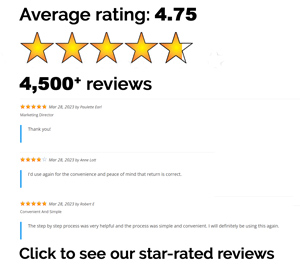The information in this article is up to date for tax year 2023 (returns filed in 2024).
If you were expecting a refund this year but didn’t receive one, there could be a few reasons why. Your refund may simply be delayed or, you didn’t qualify for a refund at all.
Below we’ll cover some of the most common reasons why you might not receive a tax refund.
First, check your refund status
If you qualify for a refund but haven’t received it, the first step is to check the status of your refund with the IRS.
Go to Where’s My Refund? at the IRS website to check your refund. (Or you can use the IRS2Go app to check your refund status on your mobile device).
You will need:
- Your Social Security or individual taxpayer ID number (ITIN)
- Your filing status
- The exact refund amount on your return
You’ll be able to check your refund status within 24 hours after the IRS receives your e-filed return, or about four weeks after mailing your paper return.
Read More: When Will I Get My Tax Refund?
How it works:
Once you’re logged in, you’ll be able to see your refund status:
- Return Received – The IRS received your return and is processing it.
- Refund Approved – The IRS approved your refund and is preparing to issue it by the date shown.
- Refund Sent – The IRS sent the refund to your bank or to you in the mail. It may take 5 days for it to show in your bank account or several weeks for your check to arrive in the mail.
If your return is delayed or was never received by the IRS, you may need to re-file your tax return.
You should only resubmit your tax return if all of these apply:
- You are due a refund
- You filed on paper more than 6 months ago
- Where’s My Refund doesn’t show that the IRS received your return.
Read More: Where’s My State Tax Refund?
5 Common reasons you didn’t get a refund
If you didn’t qualify for a refund, or never received it, here are a few reasons why that could be:
1. You are self-employed
An estimated 27 million people are self-employed in the U.S. If you are one of the many workers who traded in their W2 for a 1099 last year, your tax liability may look different from past tax years.
One of the biggest impacts on your potential refund is how self-employment taxes are calculated and paid.
Instead of having your employer withhold taxes from your paycheck, freelancers must estimate their expected income for the next year and pay quarterly taxes based on that number. If you underestimate your income, you will owe taxes at the end of the year. If you overestimate your income and thus overpay, you may receive a refund.
Note that failure to pay your quarterly estimated taxes on time can result in penalties come tax season.
Read more: How to File Small Business Taxes [A Beginner’s Guide]
2. You didn’t have enough income withheld on your paychecks
Every time you receive your paycheck, a portion of that income is withheld and paid in taxes to the government. When you start a new job, you will fill out a Form W-4, Employee’s Withholding Allowance Certificate to provide information on your filing status and any withholding allowances.
If the amount of tax withheld throughout the year falls short of your total tax liability, you will owe taxes on the difference.
Tax Tip: Use the IRS tax withholding estimator to calculate how much tax you should have your employer withhold on your paychecks.
3. You’re a victim of tax fraud
Tax season is prime time for scammers to try and weasel you out of your hard earned money. Identify thieves will impersonate the IRS to get your personal information from you so they can file a tax return in your name and steal your refund.
The IRS will never contact you by email, text messages or social media channels to request personal or financial information. So if you get an email, text or call claiming to be the IRS, it is a scam.
If you are expecting a refund but haven’t received it yet, check the status of your refund directly with the IRS. If the status says Refund Sent and it has been more than a few weeks, you may be a victim of tax fraud.
If you clicked on a link in a scam message, or you shared personal or financial information, report it at IdentityTheft.gov to get a free, customized recovery plan.
4. Your refund was used to offset a debt
If you are overdue on past tax payments, the IRS can seize your refund to apply it to your debt. This can also apply to other debts including:
- Defaulted student loans
- Past due child support
- Unemployment compensation debt
- State income tax obligations
If there are funds leftover after the debt has been paid off, your remaining refund will be issued in a check or direct deposited as originally requested on the return.
5. You didn’t claim all the tax credits and deductions you qualify for
Tax credits and tax deductions can dramatically lower your taxable income and final tax bill. But only if you claim them. The IRS won’t automatically apply credits and deductions you are eligible for. So make sure to do your research to find what deductions you may qualify for.
Get a bigger refund, faster with ezTaxReturn
Get your biggest refund, guaranteed with ezTaxReturn. Our software walks you through filing a return every step of the way. We handle all the forms and math to identify every tax credit and deduction you can claim.
The articles and content published on this blog are provided for informational purposes only. The information presented is not intended to be, and should not be taken as, legal, financial, or professional advice. Readers are advised to seek appropriate professional guidance and conduct their own due diligence before making any decisions based on the information provided.




